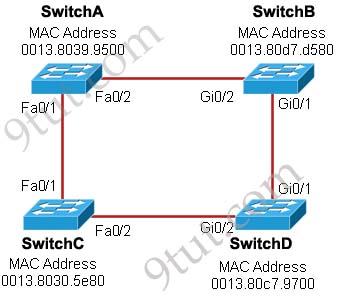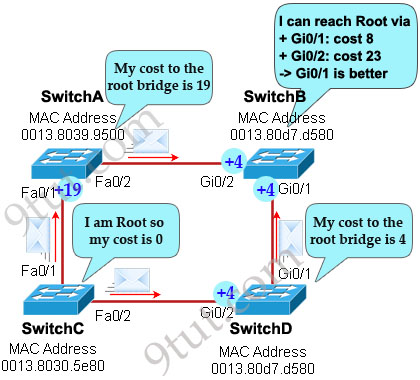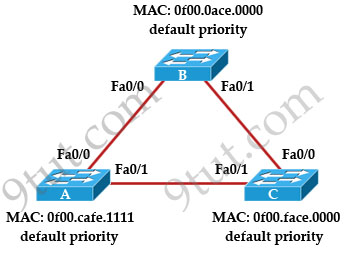CCNA – STP Questions
Here you will find answers to Spanning Tree Protocol Questions
Note: If you are not sure how STP and RSTP work, please read my STP tutorial and RSTP tutorial.
Question 1
Which three statements about RSTP are true? (choose three)
A. RSTP significantly reduces topology reconverging time after a link failure.
B. RSTP expends the STP port roles by adding the alternate and backup roles.
C. RSTP port states are blocking, discarding, learning, or forwarding.
D. RSTP also uses the STP proposal-agreement sequence.
E. RSTP use the same timer-based process as STP on point-to-point links.
F. RSTP provides a faster transition to the forwarding state on point-to-point links than STP does.
Answer: A B F
Question 2
Which two states are the port states when RSTP has converged? (choose two)
A. blocking
B. learning
C. disabled
D. forwarding
E. listening
Answer: A D
Explanation
RSTP only has 3 port states that are discarding, learning and forwarding. When RSTP has converged there are only 2 port states left: discarding and forwarding but the answers don’t mention about discarding state so blocking state (answer A) may be considered the best alternative answer.
Question 3
Which command enables RSTP on a switch?
A. spanning-tree mode rapid-pvst
B. spanning-tree uplinkfast
C. spanning-tree backbonefast
D. spanning-tree mode mst
Answer: A
Question 4
At which layer of the OSI model is RSTP used to prevent loops?
A. data link
B. network
C. physical
D. transport
Answer: A
Question 5
Refer to the exhibit. Given the output shown from this Cisco Catalyst 2950, what is the most likely reason that interface FastEthernet 0/10 is not the root port for VLAN 2?
Switch# show spanning-tree interface fastethernet0/10

A. This switch has more than one interface connected to the root network segment in VLAN 2.
B. This switch is running RSTP while the elected designated switch is running 802.1d Spanning Tree.
C. This switch interface has a higher path cost to the root bridge than another in the topology.
D. This switch has a lower bridge ID for VLAN 2 than the elected designated switch.
Answer: C
Question 6
Which two of these statements regarding RSTP are correct? (Choose two)
A. RSTP cannot operate with PVST+.
B. RSTP defines new port roles.
C. RSTP defines no new port states.
D. RSTP is a proprietary implementation of IEEE 802.1D STP.
E. RSTP is compatible with the original IEEE 802.1D STP.
Answer: B E
Question 7
Refer to the exhibit. Each of these four switches has been configured with a hostname, as well as being configured to run RSTP. No other configuration changes have been made. Which three of these show the correct RSTP port roles for the indicated switches and interfaces? (Choose three)

A. SwitchA, Fa0/2, designated
B. SwitchA, Fa0/1, root
C. SwitchB, Gi0/2, root
D. SwitchB, Gi0/1, designated
E. SwitchC, Fa0/2, root
F. SwitchD, Gi0/2, root
Answer: A B F
Explanation
The question says “no other configuration changes have been made” so we can understand these switches have the same bridge priority. Switch C has lowest MAC address so it will become root bridge and 2 of its ports (Fa0/1 & Fa0/2) will be designated ports -> E is incorrect.
Because SwitchC is the root bridge so the 2 ports nearest SwitchC on SwitchA (Fa0/1) and SwitchD (Gi0/2) will be root ports -> B and F are correct.
Now we come to the most difficult part of this question: SwitchB must have a root port so which port will it choose? To answer this question we need to know about STP cost and port cost.
In general, “cost” is calculated based on bandwidth of the link. The higher the bandwidth on a link, the lower the value of its cost. Below are the cost values you should memorize:
| Link speed | Cost |
| 10Mbps | 100 |
| 100Mbps | 19 |
| 1 Gbps | 4 |
SwitchB will choose the interface with lower cost to the root bridge as the root port so we must calculate the cost on interface Gi0/1 & Gi0/2 of SwitchB to the root bridge. This can be calculated from the “cost to the root bridge” of each switch because a switch always advertises its cost to the root bridge in its BPDU. The receiving switch will add its local port cost value to the cost in the BPDU.
One more thing to notice is that a root bridge always advertises the cost to the root bridge (itself) with an initial value of 0.
Now let’s have a look at the topology again

SwitchC advertises its cost to the root bridge with a value of 0. Switch D adds 4 (the cost value of 1Gbps link) and advertises this value (4) to SwitchB. SwitchB adds another 4 and learns that it can reach SwitchC via Gi0/1 port with a total cost of 8. The same process happens for SwitchA and SwitchB learns that it can reach SwitchC via Gi0/2 with a total cost of 23 -> Switch B chooses Gi0/1 as its root port -> D is not correct.
Now our last task is to identify the port roles of the ports between SwitchA & SwitchB. It is rather easy as the MAC address of SwitchA is lower than that of SwitchB so Fa0/2 of SwitchA will be designated port while Gi0/2 of SwitchB will be alternative port -> A is correct but C is not correct.
Below summaries all the port roles of these switches:

+ DP: Designated Port (forwarding state)
+ RP: Root Port (forwarding state)
+ AP: Alternative Port (blocking state)
Question 8
Which two protocols are used by bridges and/or switches to prevent loops in a layer 2 network? (Choose two)
A. 802.1d
B. VTP
C. 802.1q
D. STP
E. SAP
Answer: A D
Question 9
Which switch would STP choose to become the root bridge in the selection process?
A. 32768: 11-22-33-44-55-66
B. 32768: 22-33-44-55-66-77
C. 32769: 11-22-33-44-55-65
D. 32769: 22-33-44-55-66-78
Answer: A
Question 10
Refer to the topology shown in the exhibit. Which ports will be STP designated ports if all the links are operating at the same bandwidth? (Choose three)

A. Switch A – Fa0/0
B. Switch A – Fa0/1
C. Switch B – Fa0/0
D. Switch B – Fa0/1
E. Switch C – Fa0/0
F. Switch C – Fa0/1
Answer: B C D
Explanation
First by comparing their MAC addresses we learn that switch B will be root bridge as it has lowest MAC. Therefore all of its ports are designated ports -> C & D are correct.
On the link between switch A & switch C there must have one designated port and one non-designated (blocked) port. We can figure out which port is designated port by comparing their MAC address again. A has lower MAC so Fa0/1 of switch A will be designated port while Fa0/1 of switch C will be blocked -> B is correct.



sorry i cannot add picture . ..
In the picture above what if :
Switch A connects to Switch C through Gi port (port on switch A towards Switch C is still Fa)
Switch B connects to Switch A through Gi0/1 on Switch B
Switch B connects to Switch D through Gi0/2 on Switch B
Both ports in between Switch C and Switch D is Gi ports .
Will the Low speed connection to Switch A be RootPort and Gi0/2 which connects to Switch D in AP??
sorry i got the answer
@ Oak, Question 7 on your exam, did it appeared the same?
Q2,
why would cisco produced a wrong answer of blocking, instead of discarding? it’s clear that there is no blocking in RSTP..
haha foolish question…
According to me Q5 answer must be A:
if it was C, than C answer is true if and only if the “other interface” that has a lower path cost to the root is assigned to the same VLAN2.
Which exactly means that A is the answer (more interfaces to root in VLAN2).
As C is not referring to VLANS (and the switch is running a per vlan stp right?) it cannot be true, at least it is not the best choice.
The question asks which is the “most likely reason”, not the REAL TRUTH.
So for me the most likely is that another port in VLAN2 has a path to root switch.
Hi team 9tut – would you be able to explain the answer for question 9?
I think it should be C.
in this case BID = default bridge priority value 32768+Vlan iD (minimum 1 /(1-4096) ) + Mac address.
if so 32768 can not be the answer. (ccna 3 exploration 5.2.3) — show spanning-tree command will add the vlan id to show the priority value of the root id. Please help. Many thanks – Mei
@mei E: The formula here is: Bridge ID = Bridge Priority + MAC address and A has smallest Bridge Priority and smallest MAC -> It is the root bridge.
mei E
q9: we see the lowest priority and in the q9 is 32768 and then we see the lowest mac address.
Please send me the STP notes in 9tut
erangadpm@gmail.com
Q9. Why answer is A? C lower than A. Or I missed something?
Oh, I’m so sorry. I missed Bridge Priority. Answer is A of course.
hw can someone knw which mac address is lower,as some contains alphabets
pls someone shd help me out
Dear 9tut
For Q9:
Bridge priority must be an increment of 4096.. It can be 0 4096 8192 … 32768 …
32769 is not valid..
Reference ccna discovery 3 chapter 3..
Am I being wrong??
I have dodnleaded latest updates of all dumps CCNA and CCNP from ht tp:// g o o . g l / u R yl E
XXX
For Q9:
Cisco by default STP has a priority value of 38768 but being on the vlan1 this value increases to 32769 ….
Hello Guys I hope you will be fine there. I have CCNA (640-802) and CCNA security (640-554) Vouchers on special discount of 58% for World wide, with six months expiry date till you purchase. Each voucher cost 70USD.
Details Required For CCNA Voucher For Discount Processing:
1-Full Name. 1st Name & Last Name (as you want to appear on certificate & documents)
2-Country.
3-City.
4-State.
5-Pin Code (or Area Code)
6-Residential Address (or where you can collect your Certificate or further correspondence
can be received)
7-Date of birth
Add me on Skype through this information which is written below:
Skype Name: rockon660
you can also email me at this email address which is written below:
madeelqaiser@gmail.com
If you have any Questions feel free to contact me.
Thanks,
Best regards,
Adeel
@kufkov, MAC addresses use hexadecimal. Google up hexadecimal numbers. You should be knowing that by now if you are doing CCNA
Can somebody plz send me the latest dumps for CCNA .
i have an exam on the 23 of September.
email address is marjans1985@yahoo.com
Thanks
Thanks 9tut. I made it. I passed my CCNA 200-120 today. The sim is Access-list 1 , Access-list 2 & EIGRP. A lot of new questions like Netflow, Syslog, SNMP, VRRP, and GLBP.
Q7 – seems like SwA Fa0/2 should be alt (or blocking if STP) since the path cost to RB is higher than that of SwB Gi0/2. Isn’t Path Cost evaluated first before the Switch Bridge ID (which comes down to the MAC of the Switch in this case) is looked at? So I think SwB Gi0/2 is Des, and SwA Fa0/2 is Alt.
What did I miss?
@Mike M
The explanation is not really accurately, switchA f0/2 is elected because switch B root cost is not 8, why? because SwiD has a root cost of 19, because of the speed/duplex negotiation with SwitchC, the link goes down to fastethernet speed, and stp set the cost of that interface to 19.
So SwiB root cost= 19+4=23 and SwiA= 19(better)
So the Designated port is not elected by the lowest MAC.
True CCNA, the Designated Port: is the sw port that advertises the lowest-cost hello to reach the root sw (lowest STP cost). If a tie occurs: the lower sender BID wins but if both ports are connected to the same sw (the BID will be equal), so 2 additional tie breakers are needed:
1ºLowest Sender port priority wins,
2º Lowest Sender interface port number wins.
I have cleared my exam and i got the pass4sure dump from this link study material also
avaiable (( http://svn.ms/9tutcom )) all the best:”
Q1 and Q6 on exam last week.
Q7 why is switch B port Gi0/1 a Root Port please?
In regards to Q7, refer to https://learningnetwork.cisco.com/thread/24319 for an interesting debate about the cost the switch uses on interfaces. The ‘lowest MAC’ theory that has been put forward as to what determined who had the blocking port is not applicable in this case. It all still comes down to port cost.
Thanks 9tut Guru God Bless you I have pass today with 867.A well deserved break then preparation will done for CCNP switch thanks for evry1 comments it really helped.
Hi Everyone,
Is there a requirement for the new ccna 200-120 before attempting to take it? Thank for sharing.
i wanna help ..i cant understand Q 6 the meaning of
D. RSTP is a proprietary implementation of IEEE 802.1D STP.
E. RSTP is compatible with the original IEEE 802.1D STP.
thx u :)
please can someone answer this question?
Suppose we have 4 switches connected together in a network. We want to add a switch to the existing network? What changes we have to make in the existing switches? Explain briefly
kenkhan35@gmail.com
Your explanation for Q7 is totally off (although it just so happens to still work out to the correct answer). Note that those ports on the top link is a gigabit – fast ethernet, so:
The top link is a cost of 19.
The right link IS a cost of 4.
The left link is a cost of 19.
And the bottom link is a cost of 19.
<>
Because the cost to follow the link out G0/1 = 4 (plus the botton link, cost of 19) = 23
As opposed to the top link with is 19 + the left link with is also 19 = 38
Since 23 < 38, the G0/1 port wins.
flooding (broadcast) and ‘Flood and Learn bevioahr.’ I cover some of this bevioahr here () but the summary is that when a switch receives a frame for an unknown destination (MAC not
flooding (broadcast) and ‘Flood and Learn beviahor.’ I cover some of this beviahor here () but the summary is that when a switch receives a frame for an unknown destination (MAC not
At last! Someone with the insight to solve the prlembo!
What if the cost are the same, how to identify which are the root port and designated port for non-root switch